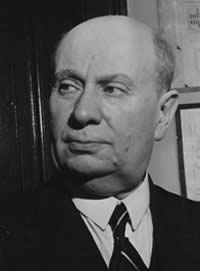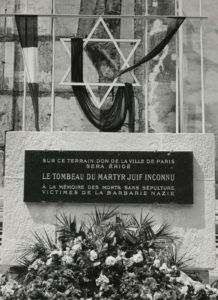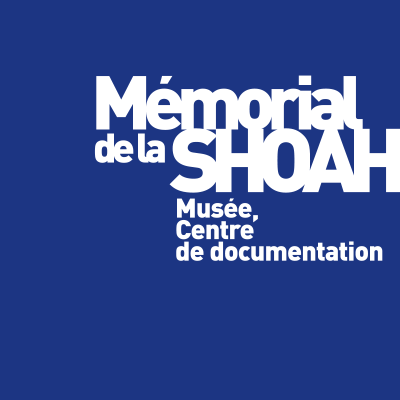History of the Shoah Memorial
The Shoah Memorial finds its origin during the war, with the creation in clandestinity of an archive fund aimed at gathering evidence of the persecution of the Jews. The Center for Contemporary Jewish Documentation later doubles as the Memorial of the Unknown Jewish Martyr. Archives center, museum, the Memorial is today an essential place of mediation for transmission.
In 1943, the objective: to document the persecution of the Jews

Isaac Schneersohn © Shoah Memorial
April 28, 1943, while France is occupied, Isaac Schneersohn, an industrialist of Russian origin, gathers in the apartment he rents on rue Bizanet in Grenoble 40 activists and leaders from different tendencies of the Jewish community in order to create an important archive fund, in the clandestinity.
While the Jewish community of France is hunted down by the Nazi occupier supplemented by the police of the government of Vichy, the objective is to set up a structure that would gather evidence of the persecution of the Jews in order to testify and seek justice as soon as the war ends. Isaac Schneersohn is in fact gathering the evidence that will give birth to the international criminal justice during the Nuremberg trial a few years later.
After this meeting in Grenoble, the founders of this archive fund, now named the Centre for Contemporary Jewish Documentation, began to gather documents, but their activity was stopped by the German invasion in September 1943 of the area until then occupied by the Italians, area in which Grenoble was located. Schneersohn joined the resistance in the Dordogne and established contacts with the French Resistance which later proved useful. While the fighting for the liberation of France has begun, Isaac Schneersohn and his team join Paris in order to save from destruction and sequestration the archival funds emanating from Vichy and the Nazi occupier.
Recovery of the archives of the Gestapo and Vichy
Helped by resistance fighters and thanks to the flair of Isaac Schneersohn and Léon Poliakov in charge of the Archives Research Service, the Centre for Contemporary Jewish Documentation (CDJC) gets its hands on valuable archives in often extraordinary conditions, such as those of the CGQJ, of the German embassy in Paris, the General Staff, the General Delegation of the Vichy Government and especially those of the anti-Jewish service of the Gestapo, one of the few recovered in Europe.
As soon as the hostilities ended, the CDJC began to classify its archives in order to study the process that had led to the destruction of the Jews of France. He created his own publishing house, published his first works on internment camps (Joseph Weill, Contribution à l'histoire des camps d'internement dans l'anti-France, Paris, CDJC) and in 1946, established the first review of the history of the Shoah, le Monde Juif.
The Documentation Centre and the trial of war criminals
Parallel to this work of history and memory, the Centre de Documentation Juive Contemporaine is solicited by the French government, through Edgar Faure, in order to support the French pleading at the Nuremberg trials. The CDJC transports its documentation to Nuremberg and has permanent representation during international and American trials, becoming one of the official recipients of all documents then in circulation.
The activity deployed by the CDJC in Nuremberg earned it the recognition of the Attorney General Telford Taylor who authorized Léon Poliakov and Joseph Billig to draw on the archives of this first major international trial. This role of assistance to justice inaugurated during the Nuremberg trials continued during the trials of those responsible and accomplices of the final solution in Germany, France, and Israel where Georges Wellers, the scientific head of the CDJC is called to testify at the Eichmann trial.
In the 1980s, the CDJC provided the French justice system with an archive document, the telex of Izieu, which allowed it to proceed with the indictment of Klaus Barbie, the head of the Gestapo of Lyon, for crimes against humanity.
From the documentation center to the Memorial of the Unknown Jewish Martyr

Inauguration of the Memorial of the unknown Jewish martyr 1953 © Shoah Memorial
In 1950, Isaac Schneersohn decides to create a memorial tomb intended for the victims of the Shoah: The Memorial of the Unknown Jewish Martyr (MMJI). This idea first arouses the opposition of a part of the Jewish community which did not want "an institution turned towards the past".
Isaac Schneersohn then strives to found a large sponsorship committee including many personalities. When the head of government of the very recent State of Israel is solicited, David Ben Gourion becomes aware that the first Memorial dedicated to the Jewish victims of Nazism will see the day in Paris. So very quickly, the State of Israel decides to erect its own Memorial, Yad Vashem, in Jerusalem, with whom the CDJC establishes privileged ties. The first stone of the Paris Memorial is laid on the May 17, 1953, on land donated by the City of Paris. Several countries, France, Belgium, Luxembourg and Yugoslavia contribute to the construction of the Memorial through the donation of works of art.
The crypt of the Memorial
The building was finally inaugurated on 30 October 1956 in the presence of 50 delegations of Jewish communities from all over the world and many political and religious personalities coming from all over Europe. Ashes from the extermination camps and the Warsaw ghetto were solemnly deposited on 24 February 1957 in the crypt of the Memorial by Chief Rabbi Jacob Kaplan.
Classified as a historical monument in 1991, the Memorial of the Unknown Jewish Martyr hosts every year the main ceremonies related to the Holocaust [Warsaw ghetto, discovery of the Auschwitz camp, Hazkarah, National Deportation Day] organized by the State or by the Jewish community.
The inauguration of the Shoah Memorial in 2005

Jacques Chirac and Simone Veil at the inauguration of the Shoah Memorial in 2005
The development of the research centre on the Shoah, which has become one of the very first in Europe, as well as that of the activities of the Memorial, particularly towards school audiences, led the board of directors of the Memorial - CDJC to propose a new stage: the creation of the Shoah Memorial.
The CDJC, which had moved to Paris after the Liberation and found its place in 1956 in the Memorial of the Unknown Jewish Martyr, still occupies a natural place within the walls of the Memorial and is open to research. With the support of the Fondation pour la Mémoire de la Shoah, the State, the City of Paris and the Île-de-France Region, the Memorial has embarked on a project to expand its building.
The new Memorial
Completed at the end of 2004, this extension has notably allowed to offer more space for researchers in the reading rooms, to deploy the permanent exhibition on the history of the Shoah, to create a multimedia space, an auditorium and to erect outside the building "the Wall of names" where the names of all the Jews deported from France were engraved.
Today, the Mémorial de la Shoah is both a museum offering a permanent exhibition, two temporary exhibitions each year and numerous cultural events (meetings, screenings, testimonies), an archive center open to research and a place of memory and transmission.
In 2012, the Shoah Memorial opened a museum in Drancy, opposite the city of La Muette, a former internment camp. Place of history and transmission, complementary to the Paris Memorial, this center aims to present the history of the camp of Drancy.
The Shoah Memorial is also present in the region and abroad. In Toulouse, the regional branch for the south of France relays the actions of the Memorial by relying on local partners and on the regional heritage. In 2016 is organized for the professors in Toulouse the first University of southern France.
Since 2018, the Shoah Memorial has expanded in the region with the CERCI - Memorial Museum of the Children of the Vel d'Hiv, then the place of memory of Chambon-sur-Lignon in 2020, the center of Jules-Isaac in 2021 and the station of Pithiviers in July 2022.
In Italy, where it has had a permanent correspondent since 2010, the Shoah Memorial develops three main types of actions: continuing education, partnerships with museums of the Resistance, and an active presence within the university network.
The Memorial is also very present in Poland, with notably memory trips and the Summer University, and in the United States where temporary exhibitions are offered to the American public thanks to local partnerships.
> Discover the spaces of the Paris Shoah Memorial and prepare your visit
> Learn more about the mission of the Memorial
DOWNLOAD THE BROCHURE OF THE DOCUMENTATION CENTER (PDF)



